Architecture & Spaces
“When Mark and I married 12 years ago,” Susan shared recently, “I started engaging him in the arts activities I enjoyed. Soon, attending the theater, ballet and the symphony became activities we enjoyed regularly together.” Susan quickly added that Mark didn’t require much convincing; business interests earlier in his life just took most of his attention. Now that he’s sold his business and retired, the arts fit right in.
Mark and Susan Susz’s introduction to the Kauffman Center came through good friends Tom and Linda Beal. “We had heard bits and pieces about a new performing arts center, but no one had really filled us in,” Susan recalls.
That issue was remedied when the Beals invited them to lunch with Julia Irene Kauffman along with a small group of potential supporters. “We were immediately impressed,” Susan shared. Mark and Susan liked the idea of Kansas City getting high-quality performance spaces for the groups they enjoyed. “Plus, we were wowed by the emphasis on quality. There was so much attention being placed on acoustics and technical excellence,” Susan added.
Later, Mark and Susan met with President & CEO Jane Chu and began to talk about a contribution to the center. After reviewing a range of naming opportunities available to donors, Mark and Susan decided to fund and name three items within the Kauffman Center, including a glass elevator that is set prominently in the grand gallery.
“I liked the centrality of this special elevator and its graceful design,” Mark said. “Funding the elevator also seemed to have a nice synergy with our personal interest in getting more people to arts performances.” Susan says that the location of the Kauffman Center is so prominent that people will easily find their way from the highway loop to the center. “Then the elevator will whisk them away to a delightful experience. I’m looking forward to everything about it,” she concludes.
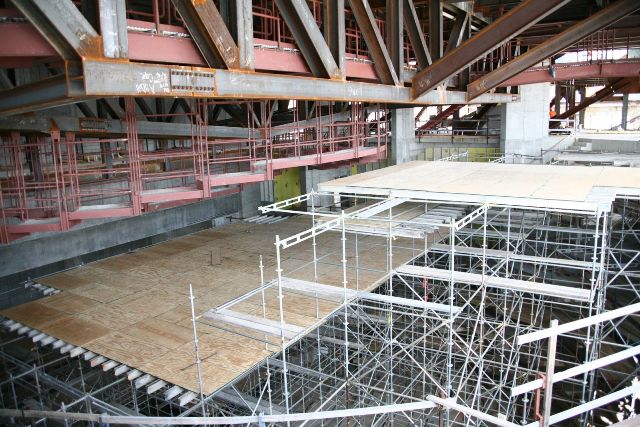
Inside the Kauffman Center, a steady stream of activity is taking place. With both performance spaces now closed off from the elements, workers can be found in almost every nook and cranny, welding, plastering, fireproofing, installing plumbing, drywall and electrical systems — just to mention a few.
These workers come from dozens of local firms that are contributing their particular expertise and artistry to this stage of the building process. Here are just a few examples of the activities taking place, and the jobs being generated, at our community’s biggest construction project.
Patent Construction Systems has been working on local construction sites for more than 45 years. Ten of their staff spent nearly two months erecting scaffolding inside both halls at the Kauffman Center. While their Quick Erect System won’t be a permanent part of the performing arts center, it plays a vital role in the building process.
Internal finishing work requires access to the highest points of the two halls, for components such as fireproofing, electrical work, ceiling installation and finish to the walls and balconies. “This requires scaffolding to support work being done as high as 70 feet,” explains Kyle McQuiston, JE Dunn Construction project manager. In the photo above the scaffolding is being completed in the proscenium theatre.
As work is finished at the highest points, interior levels of scaffolding, no longer needed for the ceiling, will be removed, while the outer perimeter will remain in place to complete walls.
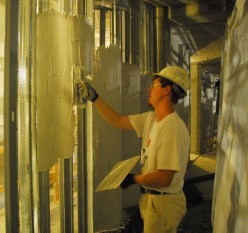 “Nothing makes us happier than to have the opportunity to allow our talented craftsmen to showcase their ability, attention to detail and outstanding quality,” says Shawn Burnum, PCI branch manager. Plasterers from PCI Dahmer are hard at work on interior finish work. Cement plastering is taking place in the ceilings, and thinner, “veneer plaster” is going into public spaces, such as lobby and hall areas.
“Nothing makes us happier than to have the opportunity to allow our talented craftsmen to showcase their ability, attention to detail and outstanding quality,” says Shawn Burnum, PCI branch manager. Plasterers from PCI Dahmer are hard at work on interior finish work. Cement plastering is taking place in the ceilings, and thinner, “veneer plaster” is going into public spaces, such as lobby and hall areas.
In the photo at right, plasterer Abel Baldwin is “scratch-coating” acoustical “bumps” in the concert hall. This first step in the plastering process prepares these unusual half moon shapes to make an important contribution to the quality of sound. Plaster must be pumped up several stories from a cement mixer below and suctioned through a tube to reach the workers.
“The ceilings in the two halls are works of art in themselves,” says Burnum. “They play an important role in deflecting sound, plus they must be safe and beautiful.” That’s a tall order for a plaster ceiling that weighs 25 pounds per square foot and is suspended high above the audience and performers.
PCI has up to 20 people at work on any particular day, doing metal stud framing, drywall insulation and fire stopping, in addition to the plaster work.
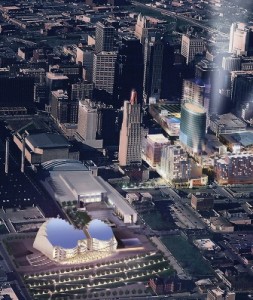
Making Powerful Connections
A 25-30 member Mark One crew is currently working at the Kauffman Center site, tackling a number of projects including:
- Five major substations
- Theatrical dimming systems
- Back-up emergency generator
- Architectural lighting
- Security system
- Telephone and data infrastructure
A year from now, this list of electrical projects will become even longer, as the exterior shell is put in place and things like sound and audio visual systems, installation of the Figaro seat-back title system, theatrical lighting and illuminating the exterior shell itself become possible. Mark One Electric is a family-owned WBE business with a long list of projects to their credit, including the JE Dunn World Headquarters, Kauffman and Chief’s stadiums, the Federal Reserve Bank and the new IRS Center.
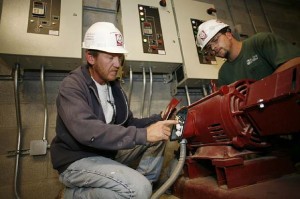
Mark One crew members check phasing for motor wiring.
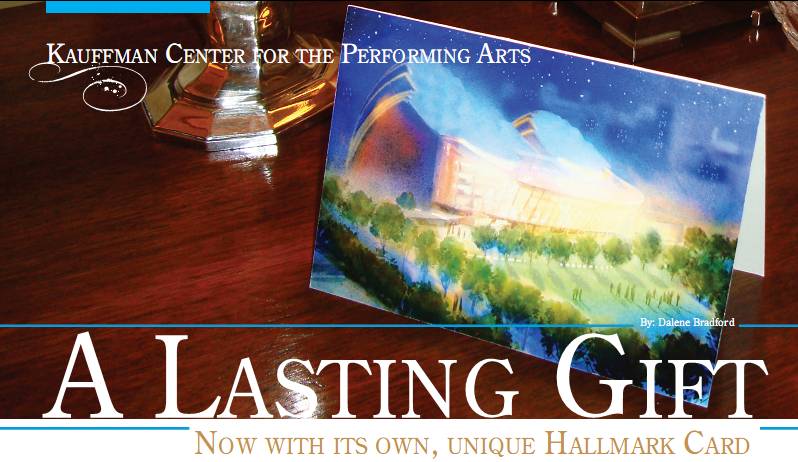
Honor Someone Special with a Space in the Kauffman Center
As you begin to think about holiday gifts, here are two unique ways to honor someone special. “Consider this an engraved invitation to anyone in the community to step forward and make a lasting imprint on this historic place,” says Jane Chu, President and CEO of the Kauffman Center.
Name a Seat
The 3,400 seats in the Kauffman Center’s two performance halls will be so special they ought to come with their own names inscribed. And, indeed, that’s exactly how you can become an integral part of this special moment in the cultural history of Kansas City. For a donation to the Kauffman Center of $2,500 to $10,000 (payable over multiple years), you can put a name on a seat. Simply print the attached form, fill it out and send it in along with your contribution.
The names donors choose will be permanently engraved on plaques embedded in the arms of the seats. They say that someone cared enough to make a lasting impression on the cultural landscape of a great city.
Attach a Special Greeting
And speaking of caring enough … now donors have a new way to acknowledge those they honor. Through a partnership with Hallmark Cards, a greeting card has been developed to accompany a gifted seat. “The card has a lovely watercolor rendering of the Kauffman Center and a message to the honoree,” says Chu. “When it’s opened, the recipient will be greeted with music from the Kansas City Symphony.”
A Gift for a Special Child in your Life

The Kauffman Center is providing parents, grandparents or anyone with a special child in their life the opportunity to give a personal gift that lasts a lifetime and also gives back to the community. The Children’s Wall is a unique donor recognition project that allows children to literally leave their handprint as a lasting impression on a landmark building. For a $1,000 donation per handprint, a child, grandchild or a youngster who deserves some special recognition can be honored. Simply fill out the attached form.
Colorful reproductions of the handprints will be artistically arranged near the escalators that rise to the majestic glass lobby of the Kauffman Center. Each handprint is personalized with a child’s name and the year the print was made.
To learn more, message contact@kauffmancenter.org.
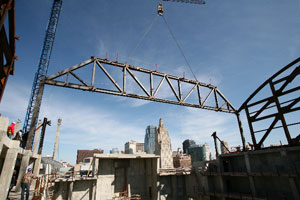 First Steel Truss is Installed
First Steel Truss is Installed
How do you get a 50-ton truss to the top of the Kauffman Center roof? With a really strong crane that can reach across the concrete base of the center and an experienced crew of steel installers carefully guiding it into place.
That’s why there’s a new crane in town. And it went to work on March 11, hoisting the first gigantic steel truss to the top of the Concert Hall. And while the center needs a roof for the obvious reasons, this part of the steel installation takes an important step toward completing the acoustic enclosure that will ensure great arts experiences.
The Kauffman Center construction site acquired a third large crane in early March. This bright red, white, and blue Demag 1800 is classified as a “600 ton crane” and was needed for several reasons.
“This crane has the ability to do “˜picks’ of 90 tons, which is required by the Kauffman Center specifications,” according to Kyle McQuiston, project executive for JE Dunn Construction. A “pick” refers to a load that is picked up, then maneuvered into place by the crane. “Plus this crane has the ability to reach out far enough, with that size load, to place the truss above the large concrete structure below,” McQuiston explains.
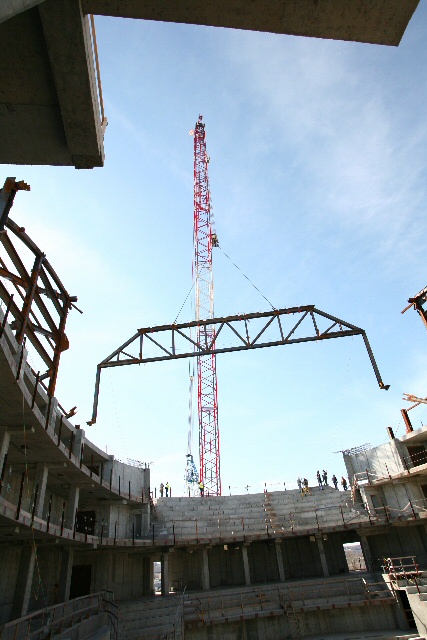 The first steel truss took just under an hour to lift into place above the Concert Hall. The trusses themselves are too large to be trucked in, so workers first must assemble and weld them together on site. The largest truss to be installed weighs 90 tons.
The first steel truss took just under an hour to lift into place above the Concert Hall. The trusses themselves are too large to be trucked in, so workers first must assemble and weld them together on site. The largest truss to be installed weighs 90 tons.
In order to reach everywhere that this crane’s special capacities are required, it will be moved three times during this phase of steel installation (to both the south and north sides of each hall). The two tower cranes currently on site cannot handle loads of this magnitude, but are required to assist the large mobile crane with connection pieces.
This new crane arrived with its own operator and will be on site for several months. “The project has the most detailed hoisting plan I’ve seen in 25 years of construction projects,” says McQuiston, as he points to a very large document on his desk. In addition, moving the crane is a major project, taking a week to ten days, as the crane must be dismantled in order to be relocated.
Construction rubberneckers on the street downtown will have a great time watching this crane do its work if the hoisting of the first truss is any indication. Even seasoned construction workers on site took time to watch the crane gingerly and precisely place tons of steel up on the roof.
- View the latest construction photos.
- Read more about the steel installation.
 For the last 10 years, Kansas City patrons have become accustomed to enjoying opera in its original language, aided by supertitle translations of lyrics and dialogue projected above the stage at the Lyric Theatre.
For the last 10 years, Kansas City patrons have become accustomed to enjoying opera in its original language, aided by supertitle translations of lyrics and dialogue projected above the stage at the Lyric Theatre.
At the Kauffman Center, audiences will have an even more personalized way to enjoy opera through an advanced titling system now being used in many theaters around the country. Each patron can choose to see the titles right at their seat. Or not. How’s that possible? “Figaro! Figaro!”
Figaro’s Simultext ® is an innovation that came about over margaritas at Maria’s in Sante Fe. The accompanying conversation was about how to make performances more accessible for patrons who had difficulty hearing at the Sante Fe Opera.
Afterwards, founder Patrick Markle worked with two other opera professionals to devise the first prototype of a personal device that takes titles directly to patrons’ seats. They soon saw that it had benefits for all theater-goers. “We think of it as a dashboard for the arts and more,” Markle says.
As a result, the Kauffman Center’s Proscenium Theatre will be outfitted with small screens behind each seat that provide the ultimate in personal choice. Markle likes to say that, with Figaro Simultext ®, “Titles are put in their place — where each patron can see them if they want and when they want.”
Similar systems are currently in use at the Seattle Opera House, the New York Metropolitan Opera, Sante Fe Opera, London’s Royal Opera House, the Vienna State Opera and the Grand Teatro del Liceu in Barcelona, Spain.
The system can deliver the words sung or spoken by single or multiple performers, three lines of text to each screen. Patrons decide if they want to see the titles and then they select the language of their choice. If they choose not to see titles, they simply touch the “off button” on their individual screen.
“The Figaro System has many advantages for our patrons,” says Ward Holmquist, musical director for the Kansas City Lyric Opera. “There will be no more “˜blind spots’ where titles can’t be read. Plus, audience members close to the stage will no longer have to crane their necks to see the titles.”
The Ballet could use the system to provide scene synopses. A lecturer speaking in Russian could be translated for the audience — in up to six languages. A theatre company could provide programming notes, casting changes or welcome a particular group of ticket holders.
Each screen is ergonomically placed just below the audience member’s view of the stage, well within a comfortable viewing angle. Importantly, each unit has a “privacy screen” so that they do not interfere with a neighbor’s enjoyment of what’s on stage.
In addition, the screens have soft lighting, not a TV-like glare. The OLED screens (organic light emitting diodes) display clear text in six languages and can fade fully, meaning that they do not constantly glow (like an LCD screen does). Plus, they are ultra-low in energy consumption.
“We’re grateful that a number of donors helped us to make Figaro available for Kansas City audiences,” says Jane Chu, President and CEO of the Kauffman Center. “It’s just one more way to assure that future performing arts experiences will be exceptional and available for everyone.”
Learn more about the Proscenium Theatre. Read theater designer Richard Pilbrow’s thoughts on a range of theatre design details.